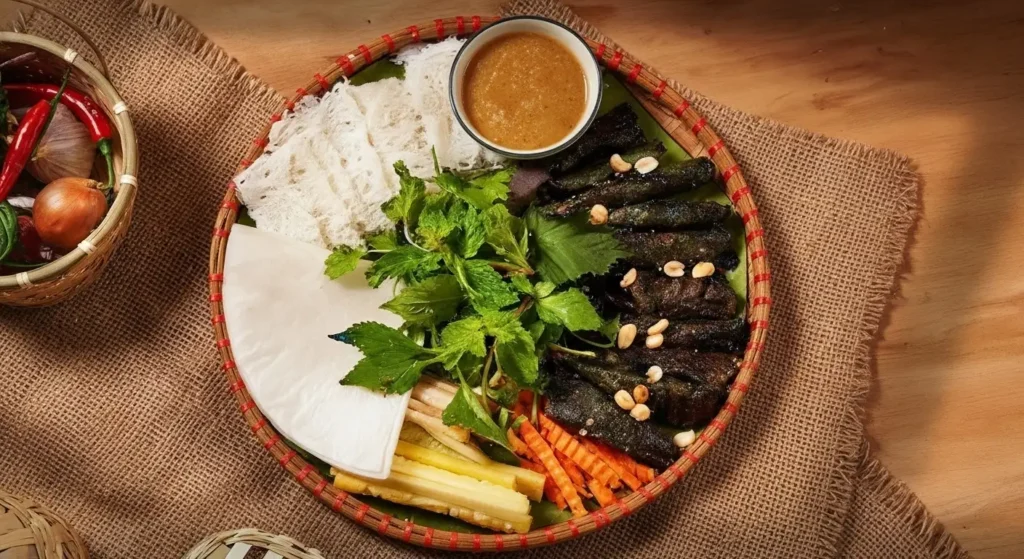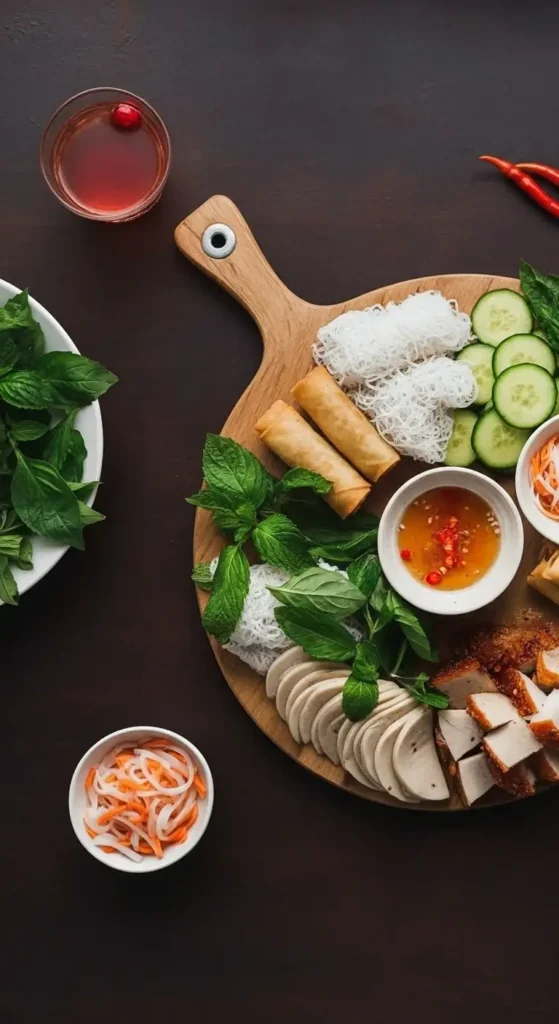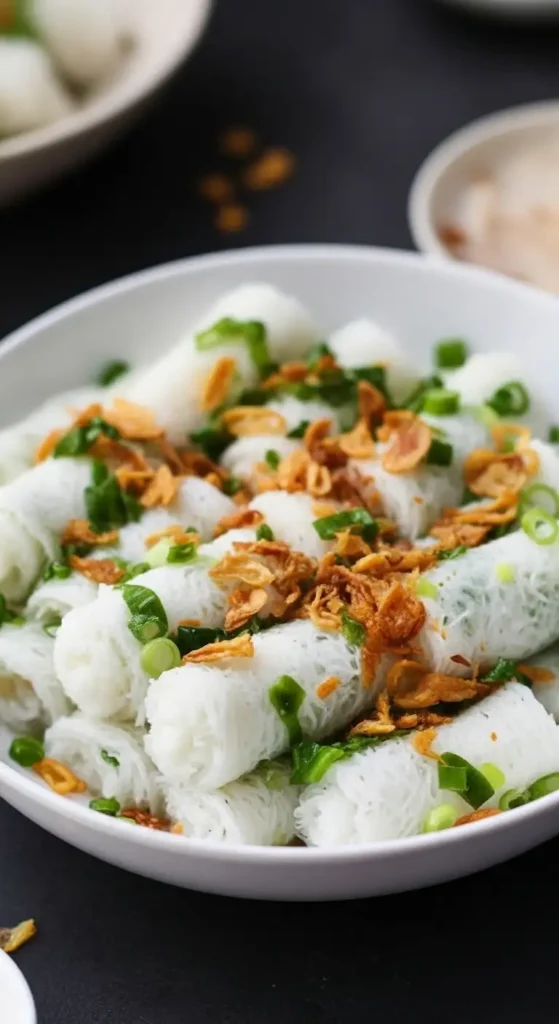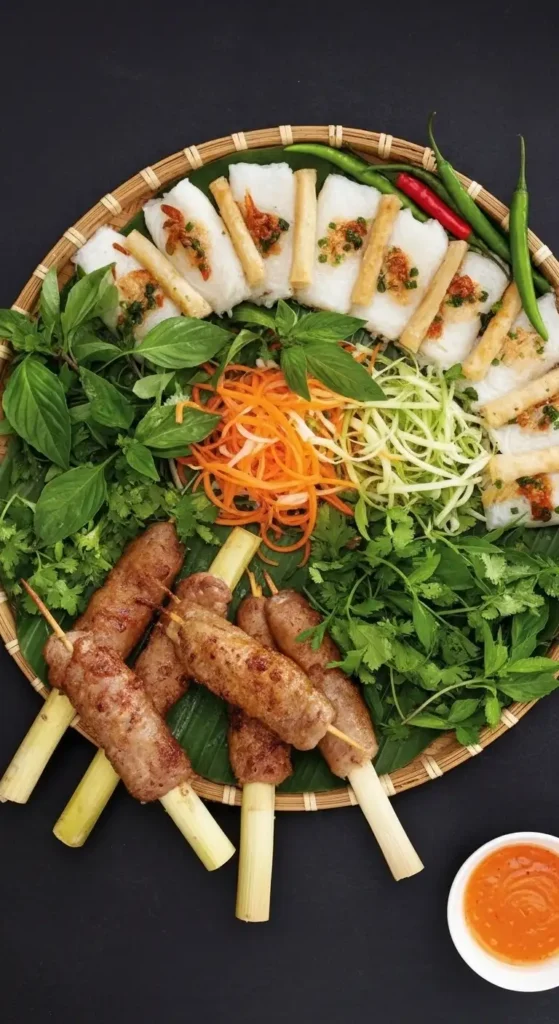Bánh Hỏi (pronounced bahn hoy or baan hoy) is one of the most unique and intricate forms of rice noodle dishes in Vietnamese cuisine. Unlike the long, loose strands of bún (vermicelli), Bánh Hỏi are fine threads of rice vermicelli meticulously woven into delicate, flat, rectangular sheets. Served at room temperature, these tender bundles are the foundation for a colorful, fresh, and interactive dining experience.

The Basics of Bánh Hỏi
What is it?
Bánh Hỏi translates to “Question Cake,” but is more descriptively known as Vietnamese Woven Rice Vermicelli Sheets or Fine Rice Noodles.
They are sheets made of countless fine, thread-like rice noodles (as thin as a toothpick) that have been pressed, woven together, and lightly steamed into flat, thin bundles.
Key Ingredients:
The sheets are made simply from rice flour, water, and salt. The process is complex, involving soaking, grinding, steaming, kneading, and finally, pressing the dough through an extremely fine sieve to create the delicate threads.
Texture and Presentation:
The noodles are soft, light, and tender but firm enough to hold their woven shape.
Before serving, the sheets are always brushed or topped with Mỡ Hành—a savory oil garnish made from chopped scallions or garlic chives sautéed in hot oil. This adds a rich aroma, verdant color, and a crucial layer of flavor.
When is it Eaten?
Bánh Hỏi is not typically eaten alone; it’s a ceremonial dish often served on festive occasions, large family gatherings, or weddings, though it is also a popular daily food in its region of origin.
Types of Bánh Hỏi Dishes
The variety of Bánh Hỏi is based almost entirely on its rich and savory accompaniments, rather than the noodle itself. The sheets serve as a delicate, neutral platform for rich grilled or roasted meats.
| Vietnamese Name | Main Accompaniment | Key Characteristics |
|---|---|---|
| Bánh Hỏi Heo Quay | Roasted Pork (Heo Quay) | A classic pairing, featuring succulent slices of Chinese-style roasted pork with crispy skin. The richness of the pork is perfectly balanced by the light noodles and fresh herbs. |
| Bánh Hỏi Nem Nướng | Grilled Pork Patties (Nem Nướng) | Rolled pork skewers or patties, often flavored with lemongrass or a sweet marinade, which are either grilled or fried. |
| Bánh Hỏi Tôm Nướng | Grilled Shrimp | Usually features large, marinated shrimp grilled over charcoal or, famously, Chạo Tôm (shrimp paste wrapped around a sugar cane stick). |
| Bánh Hỏi Thịt Nướng | Grilled Meat (Thịt Nướng) | Typically thin slices of pork, chicken, or beef marinated in lemongrass, garlic, and fish sauce, then charcoal-grilled until caramelized. |
| Bánh Hỏi Chả Giò | Fried Spring Rolls (Chả Giò) | The delicate noodles are paired with the crunch and flavor of fried spring rolls, offering a satisfying textural contrast. |

How to Enjoy Bánh Hỏi
Bánh Hỏi is an interactive, “do-it-yourself” dish, typically eaten as a fresh wrap. The preparation is key to the overall flavor.
Gather Your Components: The dish is served deconstructed on a platter. You will have the Bánh Hỏi sheets (already topped with scallion oil), a platter of various meats/seafood, a bowl of Nước Chấm (the classic sweet and sour fish sauce dipping sauce), fresh lettuce leaves, and a generous pile of fresh aromatic herbs (mint, basil, cilantro).
Make the Wrap (The DIY Roll):
Take a large leaf of lettuce (or a piece of rice paper, bánh tráng).
Place a sheet of Bánh Hỏi on the lettuce.
Add your choice of protein (e.g., a slice of roasted pork or a piece of nem nướng).
Add fresh herbs (mint, coriander) and pickled vegetables (đồ chua – pickled carrots and daikon).
Roll the lettuce leaf up into a tight, neat bundle.
Dip and Eat:
Dip the entire bundled wrap into the communal bowl of Nước Chấm.
The roll is meant to be eaten in one or two bites, delivering a complex blend of tender noodle, savory meat, crunchy vegetables, aromatic herbs, and tangy sauce.
Regional Differences in Bánh Hỏi
Bánh Hỏi is not evenly distributed across Vietnam. It has a strong historical connection to the Central and Southern regions.
| Region | Regional Characteristics and Accompaniments |
|---|---|
| Central Vietnam | Origin & Daily Staple. Bánh Hỏi is considered to have originated in the Bình Định Province (South Central Coast). In this region, it is eaten for almost any meal of the day, sometimes replacing rice or noodle soups. The Central style emphasizes the pure rice flavor and quality of the fine noodles. |
| Southern Vietnam | Ceremonial & Rich. The dish is extremely popular in the South (e.g., Ho Chi Minh City, Mekong Delta) and is a must-have item at major events like weddings and death anniversaries. Southern cuisine is generally sweeter and richer than the Central or Northern styles. |
| Northern Vietnam | Less Common. While available, Bánh Hỏi is not a traditional Northern Vietnamese staple. Northern cuisine tends to favor heartier, soup-based rice noodle dishes like Phở and Bún, making the delicate, Bánh Hỏi wrap a popular but imported specialty. |




